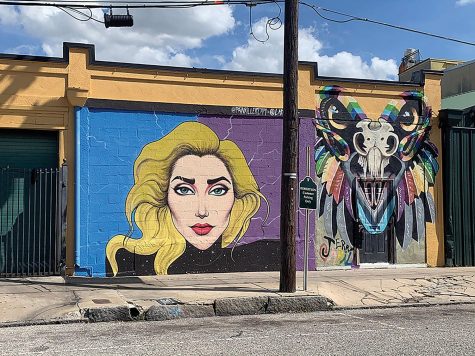A walk down artistry lane
Walking through Central Avenue Historic District, murals line the walls. The murals are a tool to help revitalize the area.
Walking along the streets of downtown Tampa, it’s not hard to find yourself walking by an intricate sculpture or a slew of murals. Over the years, Tampa has accumulated 560 different art pieces, and the Public art program is one of the oldest projects in the Bay Area to date, developing for over 35 years and counting.
On the Tampa.gov website, you can find thorough listings of art, links to museums and monuments, and current projects that the city is working on. Mayor Jane Castor herself has made her own mark on the art scene, creating the “Art on the block” project for public and private sectors alike to add their artistry to the city. Events such as Haiku from Home, Art on the Block Mural Day and Crosswalks to Classrooms were all created under Castor’s time in office.
“The intent of this program is to make art accessible to all, encourage engagement and participation in improvements that come to one’s own neighborhood The Art on the Block is a public-private partnership,” the Tampa Art on the Block Page said. “Projects are usually grassroots in nature, not typically high-budget, but frequently bring high impact results.”
 Artists featured in Art Around the Block include Gianna Russo, a writer and poet, and Jay Giroux, a local mural artist. These artists collaborate with the Art Programs Division, Neighborhood Empowerment, the Departments of Parks & Recreation and Transportation, and all Community Redevelopment Areas departments in order to achieve their artistic visions.
Artists featured in Art Around the Block include Gianna Russo, a writer and poet, and Jay Giroux, a local mural artist. These artists collaborate with the Art Programs Division, Neighborhood Empowerment, the Departments of Parks & Recreation and Transportation, and all Community Redevelopment Areas departments in order to achieve their artistic visions.
“In bringing art to the neighborhoods, ‘by & with’ the community and not in ‘service to,’ this program looks to strengthen citizenry by opening communication, creating better neighbors, building future art patrons and fostering visual literacy, reducing prejudices through dialogue and opening minds and telling the stories of the neighborhood to keep their histories alive,” the Art on the Block program said.
Because art is subjective and at times controversial, the city even has a section on its website to address the questions and concerns the public may have with public art.
“Issues regarding Public Art in historic districts can be complex and passionate,” the Tampa art program said. “Questions, such as: Can Public Art serve to preserve the identity of a neighborhood or district, or does it influence the community’s sense of history, thereby changing “Public history”? What about the sides of the story that have gone untold, and have recently become known? How are the multiple perspectives equally represented?”
In order to keep these possible problems in check, they created a list of requirements for the city. If you want your art part of the Tampa Bay area, your art must increase the presence of art in the Center City, visible to the general public, ensure that art can be enjoyed by the general public and support the promotion of the Center City as the cultural center of the region, according to rules put in place for the central city district.
“Hillsborough County’s unique heritage drives a robust and enriching arts and culture scene, and we’re proud to be part of that,” explains the art program of Hillsborough county. “We sponsor vibrant events like the Black Heritage Celebration and host an annual fine arts camp for young people. Our public art program fuels perspective-changing exhibits like the gallery of Burgert Brothers photos on display at the C. Blythe Andrews Jr. Library or the “Veritas et Justitia’’ sculpture outside the Edgecomb Courthouse.”
 There are many notable pieces of art to visit around Tampa and specifically Hillsborough county. On Instagram, @tampadowntown and @tampapublicart are pages dedicated to displaying works around the area and sometimes offer a brief history of the piece or artist. If you travel down Franklin street, you can’t turn in any direction and not see the colorful spectacles. Each unique from the other, each with its own story, the most famous in the seven-mile loop being the postcard Tampa mural.
There are many notable pieces of art to visit around Tampa and specifically Hillsborough county. On Instagram, @tampadowntown and @tampapublicart are pages dedicated to displaying works around the area and sometimes offer a brief history of the piece or artist. If you travel down Franklin street, you can’t turn in any direction and not see the colorful spectacles. Each unique from the other, each with its own story, the most famous in the seven-mile loop being the postcard Tampa mural.
“This mural serves as a historical tribute to the former businesspeople who made Central Avenue and the surrounding neighborhood a viable place to live, work, and provide essential goods & services,” the Tampa art program said. “This mural addresses more broadly the issue of moving forward with the neighborhood and community to revitalize the area and serve as the initial step towards establishing a Central Avenue Historic District.”
Other notable art pieces in the city include “Form of Wander” by Marc Fornes, created to look like an inverted mangrove and, when seen from across the river, look as if floating above the water, “Solar Rotary” by Nancy Holt, and “Wave” by Mary Ann Unger. Every nook and cranny of the city has a history and an artist honing their craft, so it is worth checking out downtown because one never knows what no discovery they could find.

